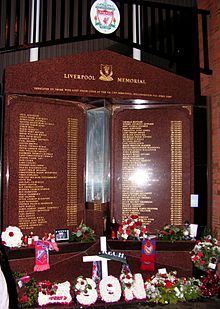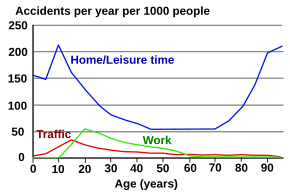
- Accident
- Accident-proneness
- Accidental incest
- Avalanche
- Carbon monoxide poisoning
- Casum sentit dominus
- Diminished value
- Domino effect accident
- Elevator surfing
- Fatality Analysis Reporting System
- Foreign body aspiration
- Golf cart accident
- Good Samaritan Law (India)
- Kickback (chainsaw)
- Latent human error
- List of deaths on eight-thousanders
- List of graffiti and street art injuries and deaths
- List of mass evacuations
- List of Mount Everest death statistics
- List of people who died climbing Mount Everest
- List of selfie-related injuries and deaths
- Mount Hood climbing accidents
- Personal watercraft–related accidents
- Plug-in electric vehicle fire incidents
- Rock fishing
- Solomon curve
- Tombstoning
- Transport accidents and incidents
- Unintentional discharge
- Use error
- When Technology Fails
Accident

An accident is an unintended, normally unwanted event that was not directly caused by humans. The term accident implies that nobody should be blamed, but the event may have been caused by unrecognized or unaddressed risks. Most researchers who study unintentional injury avoid using the term accident and focus on factors that increase risk of severe injury and that reduce injury incidence and severity. For example, when a tree falls down during a wind storm, its fall may not have been caused by humans, but the tree's type, size, health, location, or improper maintenance may have contributed to the result. Most car wrecks are not true accidents; however English speakers started using that word in the mid-20th century as a result of media manipulation by the US automobile industry.
Types
Physical and non-physical
Physical examples of accidents include unintended motor vehicle collisions, falls, being injured by touching something sharp or hot, or bumping into something while walking.
Non-physical examples are unintentionally revealing a secret or otherwise saying something incorrectly, accidental deletion of data, or forgetting an appointment.
Accidents by activity
- Accidents during the execution of work or arising out of it are called work accidents. According to the International Labour Organization (ILO), more than 337 million accidents happen on the job each year, resulting, together with occupational diseases, in more than 2.3 million deaths annually.
- In contrast, leisure-related accidents are mainly sports injuries.
Accidents by vehicle

Vehicle collisions are not usually accidents; they are mostly caused by preventable causes such as drunk driving and intentionally driving too fast. The use of the word accident to describe car wrecks was promoted by the US National Automobile Chamber of Commerce in the middle of the 20th century, as a way to make vehicle-related deaths and injuries seem like an unavoidable matter of fate, rather than a problem that could be addressed. The automobile industry accomplished this by writing customized articles as a free service for newspapers that used the industry's preferred language. Since 1994, the US National Highway Traffic Safety Administration has asked media and the public to not use the word accident to describe vehicle collisions.
Domino effect accidents
In the process industry, a primary accident may propagate to nearby units, resulting in a chain of accidents, which is called domino effect accident.
Common causes
Poisons, vehicle collisions and falls are the most common causes of fatal injuries. According to a 2005 survey of injuries sustained at home, which used data from the National Vital Statistics System of the United States National Center for Health Statistics, falls, poisoning, and fire/burn injuries are the most common causes of death.
The United States also collects statistically valid injury data (sampled from 100 hospitals) through the National Electronic Injury Surveillance System administered by the Consumer Product Safety Commission. This program was revised in 2000 to include all injuries rather than just injuries involving products. Data on emergency department visits is also collected through the National Health Interview Survey. In The U.S. the Bureau of Labor Statistics has available on their website extensive statistics on workplace accidents.
Accident models

Many models to characterize and analyze accidents have been proposed, which can be classified by type. No single model is the sole correct approach. Notable types and models include:
- Sequential models
- Domino Theory
- Loss Causation Model
- Complex linear models
- Energy Damage Model
- Time sequence models
- Generalized Time Sequence Model
- Accident Evolution and Barrier Function
- Epidemiological models
- Gordon 1949
- Onward Mappings Model based on Resident Pathogens Metaphor
- Process model
- Benner 1975
- Systemic models
- Rasmussen
- Reason Model of System Safety (embedding the Swiss cheese model)
- Woods, 1994
- Non-linear models
- System accident
- Systems-Theoretic Accident Model and Process (STAMP)
- Functional Resonance Analysis Method (FRAM)
- Assertions that all existing models are insufficient
Ishikawa diagrams are sometimes used to illustrate root-cause analysis and five whys discussions.
See also
General
- Accident analysis
- Accident-proneness
- Idiot-proof
- Injury
- Injury prevention
- List of accidents and disasters by death toll
- Safety
- Safety engineering
- Risk management
Transportation
Other specific topics
- Aisles: Safety and regulatory considerations
- Explosives safety
- Nuclear and radiation accidents
- Occupational safety and health
- Sports injury
External links
| Overview | |||||||||||||||||||||||||||||||||||||||||||||
|---|---|---|---|---|---|---|---|---|---|---|---|---|---|---|---|---|---|---|---|---|---|---|---|---|---|---|---|---|---|---|---|---|---|---|---|---|---|---|---|---|---|---|---|---|---|
| Disasters |
|
||||||||||||||||||||||||||||||||||||||||||||
| Preparation | |||||||||||||||||||||||||||||||||||||||||||||
| Countermeasures | |||||||||||||||||||||||||||||||||||||||||||||
| Media | |||||||||||||||||||||||||||||||||||||||||||||
| Organizations | |||||||||||||||||||||||||||||||||||||||||||||

